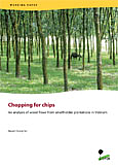Chopping for chips
-----------------
This paper aims to provide a better understanding of the wood flows from smallholder plantations to industrial buyers in the Binh Dinh and Phu Tho provinces of Vietnam. It describes the actors involved in the market chains, their respective roles, the value added to the wood in the market chain and the distribution of costs and benefits. Various differences between the two provinces exist. In Binh Dinh, wood flows are relatively direct and the market price information is transparent. There are various end-buyers but most are buying bark-clean logs. The division of labour is clear among actors. Plantation wood brings substantial income for the tree growers, yet there is great potential to improve their income through better marketing. In the Phu Tho province, the situation is more complex with various levels of intermediaries.
 The most striking difference is that most actors have poor access to price information, even in the wholesale market. Markets are more varied with four main types of wood; the most prominent are woodchips and bark-clean logs. The end-buyer market of these products is dominated by Bai Bang Paper Mill because it is located close to the tree growers. At site level, the division of labour is not as clear as in Binh Dinh. The farm gate price in Phu Tho is much lower than the price in Binh Dinh, thus tree growers in Phu Tho have a lower income from wood sales. Plantation wood plays an important part in local livelihoods, but there is still room for improvement.
The most striking difference is that most actors have poor access to price information, even in the wholesale market. Markets are more varied with four main types of wood; the most prominent are woodchips and bark-clean logs. The end-buyer market of these products is dominated by Bai Bang Paper Mill because it is located close to the tree growers. At site level, the division of labour is not as clear as in Binh Dinh. The farm gate price in Phu Tho is much lower than the price in Binh Dinh, thus tree growers in Phu Tho have a lower income from wood sales. Plantation wood plays an important part in local livelihoods, but there is still room for improvement.
---------------

